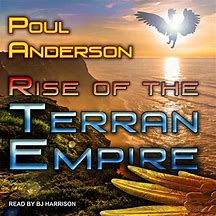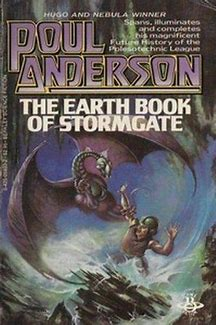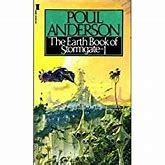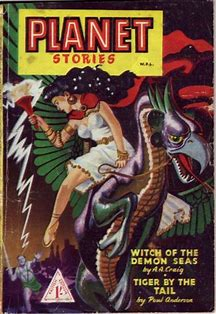"'We'll have to get a research and development effort mounted on Terra,' she said. 'For some kind of helmet or whatever, that screens off transmission of thoughts.'
"'Of course. That doesn't help us today. Not very much in the long run, really. Our people don't often encounter Chereionites, do they/'"
"'Welcome, Sir Dominic. The cloakroom slave will furnish you with a mind-screen.'
"'What?' Despite himself, Flandry started.
"'If you want one.' Ruethen bared powerful teeth at Lady Diana."
-Poul Anderson, "Hunters of the Sky Cave" IN Anderson, Sir Dominic Flandry: The Last Knight Of Terra (Riverdale, NY, March 2012), pp. 149-301 AT I, p. 156.
Flandry recognizes "...the gaunt black shape among the rainbow Terrans..." (ibid.) and runs to the cloakroom where he snaps, "'Mind-screen...'" (ibid.) When the slave girl replies that she has only a few and that:
"'His lordship told me to keep them for -'" (ibid.)
- Flandry interrupts, "'Me!'" (p. 157), snatches the gadget and places it on his head. It is a:
"...cap of wires, transistors, and power cells..." (ibid.)
- which:
"...heterodynes the energy radiation of the cerebral cortex in a random pattern. Makes it impossible to read what I'm thinking.'" (ibid.)
"'Aren't you the gaudy one, though. What style is that?'"
-Poul Anderson, A Knight Of Ghosts And Shadows IN Sir Dominic Flandry..., pp. 339-606 AT IX, p. 455.
Flandry wears a turban from Dehiwala on Ramanujan to conceal his mind-screen. When:
"'...poor mortified Tachwyr is gone...'" (p. 460)
- and Aycharaych has joined Flandry, the Chereionite comments:
"'I could wish your turban did not cover a mindscreen and powerpack, my friend. Not merely does the field make an ugliness through my nerves amidst this frozen serenity; I would fain be in true communion with you.'" (p. 459)
Flandry's men are also screened. Aycharaych asks:
"'Does not that apparatus on their heads make sleep difficult?'" (ibid.)
- and warns:
"I warn you in any case, wear the things not overmany days at a stretch. Even for a race like yours, it is ill to keep the brain walled off from those energies which inspirit the universe, behind a screen of forces that themselves must roil your dreams.'" (ibid.)
And I think that that exhausts the information about mind-screens.











































